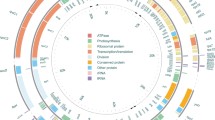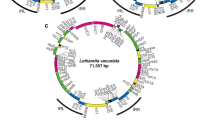Summary
A phylogenetic tree has been constructed from comparisons of entire 16S rRNA gene sequences from different prokaryotes and from several algal plastids. According to this study, and to previous work on the ribulose-1,5-bisphosphate carboxylase oxygenase (Rubisco) large and small subunit genes, we postulate that: (1) rhodophyte and chromophyte plastid genomes have a common, composite phylogenetic origin which implies at least two different ancestors, a cyanobacterial and a β-proteobacterial ancestor; (2) chlorophyte (green algae and land plants) plastids have a cyanobacterial ancestor which probably differs from that of rhodophyte and chromophyte plastids, and in any case constitute a different lineage; (3) euglenophyte plastid genomes also seem to have a composite phylogenetic origin which involves two different lineages.
Similar content being viewed by others
References
Assali NE, Mache R, Loiseaux-de Goër S (1990) Plant Mol Biol 15:307–315
Assali NE, Martin WF, Somerville CC, Loiseaux-de Goër S (1991) Plant Mol Biol (in press)
Boczar BA, Delaney TP, Cattolico RA (1989) Proc Natl Acad Sci USA 86:4996–4999
Buchheim MA, Turmel M, Zimmer EA, Chapman RL (1990) J Phycol 26:689–699
Carbon P, Ehresmann C, Ehresmann B, Ebel JP (1979) Eur J Biochem 100:399–410
Douglas SE, Durnford DG, Morden CW (1990) J Phycol 26:500–508
Douglas SE, Murphy CA, Spencer DF, Gray MW (1991) Nature 350:148–151
Dron M, Rahire M, Rochaix JD (1982) Nucleic Acids Res 10:7609–7620
Gibbs SP (1981) Ann NY Acad Sci 361:193–207
Gibbs SP (1990) In: Weissner W, Robinson DG, Starr RC (eds) Experimental phycology, vol 1. Springer Verlag, Berlin, New York, pp 145–157
Graf L, Roux E, Stutz E, Kössel H (1982) Nucleic Acids Res 10:6369–6381
Hiratsuka J, Shimada H, Whittier R, Ishibashi T, Sakamoto M, Mori M, Kondo C, Honji Y, Sun CR, Meng BY, Li YO, Kanno A, Nishizawa Y, Hirai A, Shinozaki K, Sugiura M (1989) Mol Gen Genet 217:185–194
Hirsch PR (1990) In: Fry JC, Dray MJ (eds) Bacterial genetics in natural environments. Chapman Hall, London, UK, pp 31–40
Huss VAR, Giovannoni SJ (1989) Nucleic Acids Res 17:9487
Loiseaux-de Goër S, Markowicz Y, Sommerville CC (1991) In: Mache R, Stutz E, Subramanian AR (eds) The translational apparatus of photosynthetic organelles. Nato Asi Series, vol H55, pp 19–30
Maid U, Zetsche K (1990) Nucleic Acids Res 18:3996
Maynard-Smith J, Dowson CG, Spratt BG (1991) Nature 349:29–31
Markowicz Y, Loiseaux-de Goër S, Mache R (1988a) Curr Genet 14:599–608
Markowicz Y, Mache R, Loiseaux-de Goër S (1988b) Plant Mol Biol 10:465–469
Neefs JM, Van de Peer Y, Hendriks L, De Wachter R (1990) Nucleic Acids Res 18:2237–2317
Ohyama K, Fukuzawa H, Kohchi T, Shirai H, Sano T, Sano S, Umesono K, Shiki Y, Takeuchi M, Chang Z, Aota SI, Inokuchi H, Ozeki H (1986) Plant Mol Biol Rep 4:148–175
Schwarz Z, Kössel H (1980) Nature 283:739–742
Siemeister G, Hachtel W (1990) Curr Genet 17:433–438
Turner S, Burger-Wiersma T, Giovannoni SJ, Mur LR, Pace NR (1989) Nature 337:380–382
Tohdoh N, Sugiura M (1982) Gene 17:213–218
Tomioka N, Sugiura M (1983) Mol Gen Genet 191:46–50
Valentin K, Zetsche K (1990a) Plant Mol Biol 15:575–584
Valentin K, Zetsche K (1990b) Mol Gen Genet 222:425–430
Von Allmen JM, Stutz E (1988) Nucleic Acids Res 16:1200
Witt D, Stackebrandt E (1988) Arch Microbiol 150:244–248
Woese CR (1987) Microbiol Rev 51:221–271
Yang D, Oyaizu Y, Oyaizu H, Olsen GJ, Woese CR (1985) Proc Natl Acad Sci USA 82:4443–4447
Yamada T (1988) Nucleic Acids Res 16:9865
Author information
Authors and Affiliations
Additional information
Communicated by J.-D. Rochaix
Rights and permissions
About this article
Cite this article
Markowicz, Y., de Goër, S.L. Plastid genomes of the Rhodophyta and Chromophyta constitute a distinct lineage which differs from that of the Chlorophyta and have a composite phylogenetic origin, perhaps like that of the Euglenophyta. Curr Genet 20, 427–430 (1991). https://doi.org/10.1007/BF00317073
Issue Date:
DOI: https://doi.org/10.1007/BF00317073




